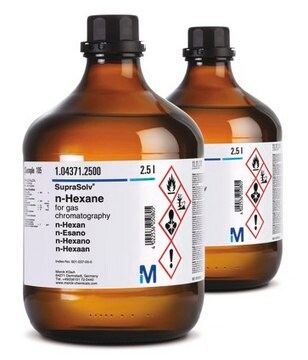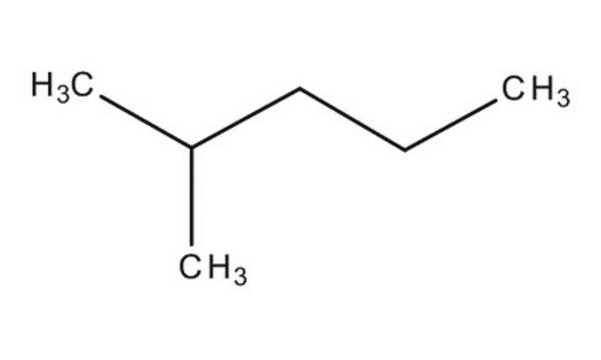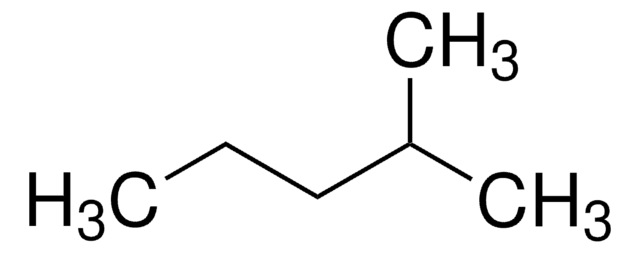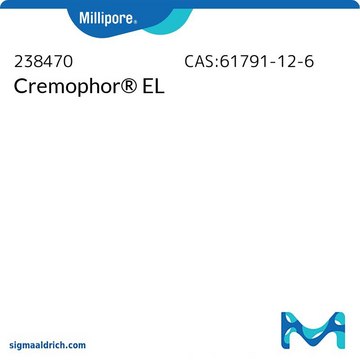1.04335
Isohexane
≥99.0% (GC), suitable for HPLC
Synonyme(s) :
Isohexane, 2-Methyl pentane, iso-Hexane
About This Item
Produits recommandés
Nom du produit
Isohexane, for liquid chromatography LiChrosolv®
Pression de vapeur
160-190 hPa ( 20 °C)
Niveau de qualité
Description
isocratic
Gamme de produits
LiChrosolv®
Essai
≥99.0% (GC)
Forme
liquid
Température d'inflammation spontanée
260 °C
Puissance
>2000 mg/kg LD50, oral (Rat)
>2000 mg/kg LD50, skin (Rabbit)
Limite d'explosivité
1.0-7.4 % (v/v)
Technique(s)
HPLC: suitable
Impuretés
≤0.0002 meq/g Acidity
≤0.0002 meq/g Alkalinity
≤0.005% Water
≤0.5% n-Hexane (GC)
≥60% Isohexane (GC)
Résidus d'évap.
≤2.0 mg/L
Couleur
APHA: ≤10
Transmittance
210 nm, ≥60%
220 nm, ≥80%
245 nm, ≥98%
Viscosité cinématique
0.5 cSt(20 °C)
pb
53-63 °C/1013 hPa
Pf
<-50 °C
Température de transition
flash point -21 °C
Densité
0.66 g/cm3 at 20 °C
Température de stockage
2-30°C
Chaîne SMILES
C(CCC)CC
InChI
1S/C6H14/c1-3-5-6-4-2/h3-6H2,1-2H3
Clé InChI
VLKZOEOYAKHREP-UHFFFAOYSA-N
Description générale
Application
- In-house validation of accelerated solvent extraction-gas chromatography-mass spectrometry for the determination of bound 3- and 2-monochloropropanediols (MCPD) and glycidol in food products.: This study showcases the validation of a robust analytical method, crucial for ensuring food safety and compliance with regulations. The use of isohexane in the process highlights its application in improving extraction efficiency and analysis precision (Shaari et al., 2021).
- Optimized determination of polybrominated diphenyl ethers and polychlorinated biphenyls in sheep serum by solid-phase extraction-gas chromatography-mass spectrometry.: Demonstrates the refinement of extraction and detection techniques using isohexane for environmental pollutants in biological samples, enhancing the sensitivity and accuracy of these measurements (Zhang & Rhind, 2011).
- Simultaneous extraction and clean-up of polybrominated diphenyl ethers and polychlorinated biphenyls from sheep liver tissue by selective pressurized liquid extraction and analysis by gas chromatography-mass spectrometry.: This article describes a streamlined method to simultaneously extract and purify specific contaminants from liver tissue, with isohexane playing a critical role in the efficiency of the extraction process (Zhang et al., 2011).
- Selective pressurized liquid extraction of estrogenic compounds in soil and analysis by gas chromatography-mass spectrometry.: Focuses on the targeted extraction of hormone disruptors from environmental samples, where isohexane′s selective solvation properties are utilized to enhance the selectivity and yield of the analytes (Zhang et al., 2011).
- Fast sample preparation involving MASE and coupled column normal phase liquid chromatography for the rapid trace analysis of dioxins in air-dust samples from fire catastrophe emissions.: Discusses a rapid preparation and analysis method for trace contaminants in complex matrices, underscoring isohexane′s role in achieving fast and reliable results (van Beuzekom et al., 2004).
Notes préparatoires
Remarque sur l'analyse
Isohexane (GC): ≥ 60.0 %
n-Hexane (GC): ≤ 0.5 %
Evaporation residue: ≤ 2.0 mg/l
Water: ≤ 0.005 %
Colour: ≤ 10 Hazen
Acidity: ≤ 0.0002 meq/g
Alkalinity: ≤ 0.0002 meq/g
Transmission (at 210 nm): ≥ 60 %
Transmission (at 220 nm): ≥ 80 %
Transmission (from 245 nm): ≥ 98 %
Filtered by 0.2 µm filter
Autres remarques
Informations légales
Mention d'avertissement
Danger
Mentions de danger
Conseils de prudence
Classification des risques
Aquatic Chronic 2 - Asp. Tox. 1 - Flam. Liq. 2 - Skin Irrit. 2 - STOT SE 3
Organes cibles
Respiratory system
Code de la classe de stockage
3 - Flammable liquids
Classe de danger pour l'eau (WGK)
WGK 2
Point d'éclair (°F)
-5.8 °F
Point d'éclair (°C)
-21 °C
Certificats d'analyse (COA)
Recherchez un Certificats d'analyse (COA) en saisissant le numéro de lot du produit. Les numéros de lot figurent sur l'étiquette du produit après les mots "Lot" ou "Batch".
Déjà en possession de ce produit ?
Retrouvez la documentation relative aux produits que vous avez récemment achetés dans la Bibliothèque de documents.
Les clients ont également consulté
Notre équipe de scientifiques dispose d'une expérience dans tous les secteurs de la recherche, notamment en sciences de la vie, science des matériaux, synthèse chimique, chromatographie, analyse et dans de nombreux autres domaines..
Contacter notre Service technique














